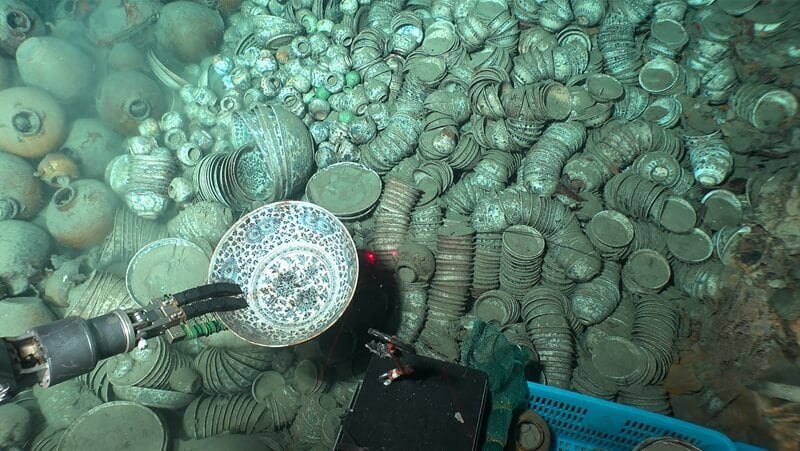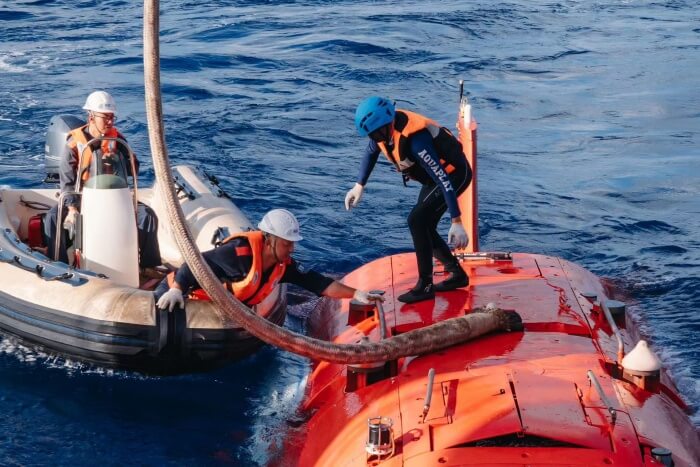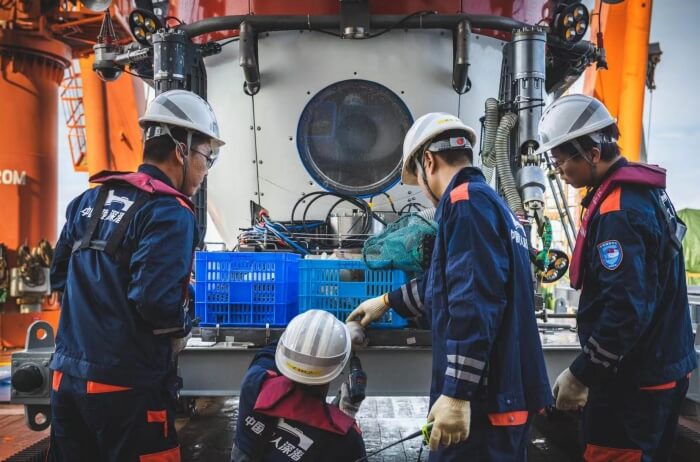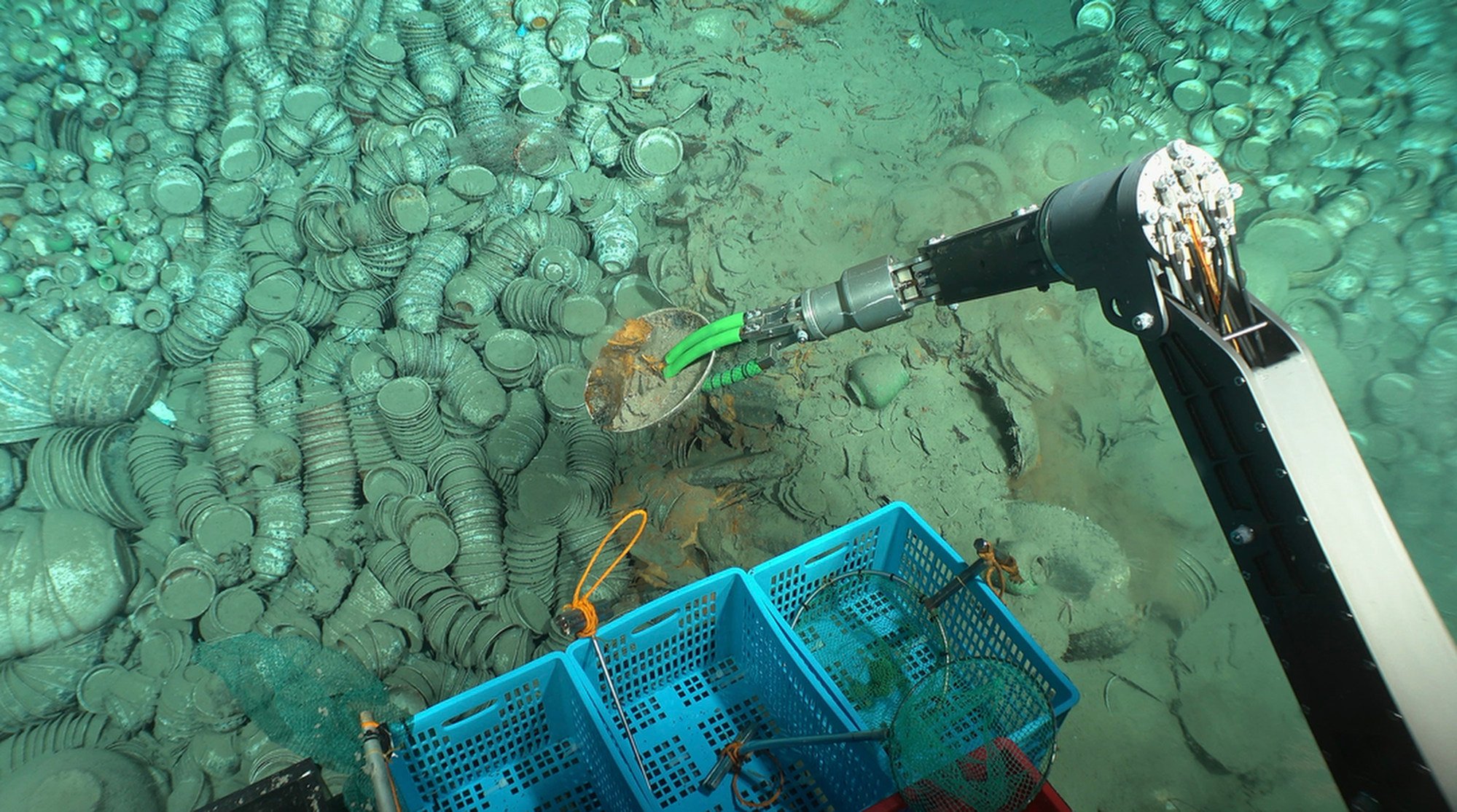Shipwrecks filled with Ming Dynasty relics found undersea
From Maritime Executive
China's archaeological authority announced Thursday that more than 900 valuable relics have been recovered from two wrecks in the South China Sea, providing physical evidence for China's history-based claim to ownership over this area of international waters.
The wrecks, dubbed No.1 and No. 2, are located just off the southern tip of China's Hainan Island.
They were found accidentally, back-to-back, over the course of two days in October 2022.
China's archaeological authority announced Thursday that more than 900 valuable relics have been recovered from two wrecks in the South China Sea, providing physical evidence for China's history-based claim to ownership over this area of international waters.
The wrecks, dubbed No.1 and No. 2, are located just off the southern tip of China's Hainan Island.
They were found accidentally, back-to-back, over the course of two days in October 2022.
An archaeological investigation on two ancient shipwrecks discovered in the South China Sea was launched in May 2023, opening a new chapter of China's deep-sea archaeology, according to a press conference held at this period in Sanya, south China's Hainan Province.
During the first archaeological survey of the No.1 shipwreck, located near the northwest continental slope of the South China Sea, researchers successfully established a permanent underwater mapping foundation in the southwest corner of the shipwreck site.
The preliminary search and investigation as well as image recording were also carried out, according to the National Cultural Heritage Administration (NCHA).
In October 2022, two ancient shipwrecks were discovered at an underwater depth of about 1,500 meters near the northwest continental slope of the South China Sea.
One mainly consists of porcelain relics, estimated to contain more than 100,000 pieces dating back to the reign of Emperor Zhengde of the Ming Dynasty (1506-1521).
The other, No. 2 shipwreck, mainly contains a large number of wood logs.
Through a preliminary study, it was determined that the ship in question was loaded with cargo and had sailed from overseas to ancient China.
It dates back to the reign of Emperor Hongzhi of the Ming Dynasty (1488-1505).
With the approval of NCHA, joint efforts between research institutes and a local museum will be made to carry out further archaeological investigations involving the two shipwrecks in three phases for about a year.
The sites sit at a depth of about 1,500 meters below the surface, making them the deepest Chinese wreck finds in the South China Sea.
Imagery provided by a state research institution shows few signs of the ships' structures, but stacks of cargo from both of the wrecks are neatly laid out on the bottom in rows.
"The hull, the wood or planks of the hull no longer exist.
They were all eaten by termites," explained Song Jianzhong, project leader of the archaeological investigation.
Imagery provided by a state research institution shows few signs of the ships' structures, but stacks of cargo from both of the wrecks are neatly laid out on the bottom in rows.
"The hull, the wood or planks of the hull no longer exist.
They were all eaten by termites," explained Song Jianzhong, project leader of the archaeological investigation.
"They symbolize China's underwater archaeology has reached the deep sea and help us understand the marine civilization in China," said Song Jianzhong, a researcher at the National Center for Archaeology.

Robotics arms are used in the underwater discovery of a shipwreck wite
Courtesy of National Cultural Heritage Administration
Pottery items date the wreckage to the Ming Dynasty, roughly 1350-1650 AD.
Chinese researchers believe that both ships were operating on the trade lane now known in China as the Maritime Silk Road.
"The cargo [of No.1] was mainly Jingdezhen [Ming dynasty] kiln porcelain, and it is speculated that it was a private merchant ship that departed from Fujian or Guangdong and headed for a trade transit point such as Malacca," said Song Jianzhong, research librarian of the National Cultural Heritage Administration (NCHA) Archaeological Research Center, in a statement last year.
Chinese researchers believe that both ships were operating on the trade lane now known in China as the Maritime Silk Road.
"The cargo [of No.1] was mainly Jingdezhen [Ming dynasty] kiln porcelain, and it is speculated that it was a private merchant ship that departed from Fujian or Guangdong and headed for a trade transit point such as Malacca," said Song Jianzhong, research librarian of the National Cultural Heritage Administration (NCHA) Archaeological Research Center, in a statement last year.
courtesy of CCTV
The NCHA investigated the two sites using the research sub Deep Sea Warrior in 2023-24.
According to the agency, 890 relics were recovered from wreck No.1, including pottery, porcelain and copper coins.
The No.2 wreck's cargo was made up of logs (ebony, which sinks in water), and 38 items of value were recovered, including pottery and deer antlers.
The contents of the cargoes demonstrate both export and import activity, according to the NCHA, on a route with modern geopolitical importance to Beijing.
The Institute of Deep Sea Science and Engineering of the Chinese Academy of Sciences provided technical assistance for reaching the depth of the wreck sites.
The NCHA's previous projects have focused on shallow-water wreck sites, within the reach of commercial diving techniques - but with an advanced deep-sea submersible, the agency was able to expand its capabilities.
The work at the No.1 site started with a photogrammetric survey of the wreckage field, followed by relic extraction.
The team said that it took great care and followed strict procedures to avoid crushing the pottery with the sub's manipulator arms, or smashing it during the hoisting and recovery of the sub at the surface.

According to the agency, 890 relics were recovered from wreck No.1, including pottery, porcelain and copper coins.
The No.2 wreck's cargo was made up of logs (ebony, which sinks in water), and 38 items of value were recovered, including pottery and deer antlers.
The contents of the cargoes demonstrate both export and import activity, according to the NCHA, on a route with modern geopolitical importance to Beijing.
The Institute of Deep Sea Science and Engineering of the Chinese Academy of Sciences provided technical assistance for reaching the depth of the wreck sites.
The NCHA's previous projects have focused on shallow-water wreck sites, within the reach of commercial diving techniques - but with an advanced deep-sea submersible, the agency was able to expand its capabilities.
The work at the No.1 site started with a photogrammetric survey of the wreckage field, followed by relic extraction.
The team said that it took great care and followed strict procedures to avoid crushing the pottery with the sub's manipulator arms, or smashing it during the hoisting and recovery of the sub at the surface.


Images courtesy Institute of Deep Sea Science and Engineering, Chinese Academy of Sciences
The discoveries align with China's objective to establish a record of past Chinese maritime activity.
Beijing claims sovereignty over the overwhelming majority of the South China Sea under its "nine-dash-line" policy, underpinned by a historical record of Chinese navigation in the region.
In 2016, the Permanent Court of Arbitration in the Hague dismissed China's claim to 90 percent of the South China Sea as inconsistent with the UN Convention on the Law of the Sea.
UNCLOS defines the limits of national control based on physical distance from land - not historical presence on the water.
China has ignored the ruling and continues to press its claims, often by force.
"The discovery provides evidence that Chinese ancestors developed, utilized and traveled to and from the South China Sea, with the two shipwrecks serving as important witnesses to trade and cultural exchanges along the ancient Maritime Silk Road," said Guan Qiang, deputy head of the NCHA, in a statement Thursday.
"This deep-sea archaeological investigation, integrating China's deep-sea science and technology, and underwater archaeology, marks the country's achievement of a world-class level in deep-sea archaeology."
Links :


No comments:
Post a Comment